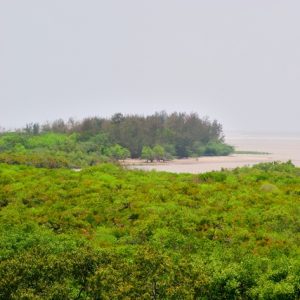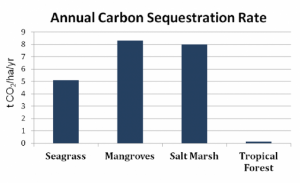On World Wetlands Day: The Allure And Elusiveness Of Mangroves As Carbon Sinks
Wetlands, and especially mangrove forests, sequester far more carbon per square mile than do tropical forests, and they also provide shelter for fish, protect the coast from storm surges, and keep coral reefs alive. On World Wetlands day, we examine the unappreciated value of these critical ecosystems.

2 February 2016 | It’s hard to imagine a more valuable ecosystem than a mangrove forest. These wooded coastal wetlands protect the shoreline from both sudden storms and gradual erosion; they provide shelter for young fish, breeding grounds for shrimp, and wood for local villagers – all of which are the fruits of clearly delineated ecosystem services, each of which has clear human beneficiaries.
This should, in theory, make it easy to find money for mangrove protection. Tourism operators and industrial fishers, for example, both have an interest in keeping coral reefs alive, and mangroves support them too, while anyone along the shore has an interest in keeping the sea at bay, as the people of Louisiana and coastal Indonesia can attest.
[Study Sees $1.6 Billion For Blue Carbon In Louisiana Wetlands]
Unfortunately, in most developing countries, the people who depend the most on mangroves don’t have the money or political clout to protect them. This leaves the carbon market as an intriguing way to keep these buffers alive.
Gold in Blue Carbon
Mangroves are disappearing at a rate of 2% per year, according to Ecosystem Marketplace’s 2014 report, “Turning over a New Leaf: State of the Forest Carbon Markets“, which offers a solid argument for investing in “blue carbon” projects that slow climate change by saving or restoring seagrasses, tidal salt marshes, and mangroves. The concept became a hot topic in 2009, with the publication of two reports: “Blue Carbon: The Role of Healthy Oceans in Binding Carbon” and “The Management of Natural Coastal Carbon Sinks”. Since then, the American Carbon Registry (ACR), the Verified Carbon Standard (VCS), and the Climate Action Reserve (CAR) have all established clear rules for developing projects. But our 2015 report, “Converging at the Crossroads: State of Forest Carbon Finance“, found that buyers hadn’t yet caught on; there weren’t yet enough blue carbon transactions to report on them as a unique category.
At recent climate talks in Paris, however, Australian Minister for the Environment Greg Hunt launched the International Partnership for Blue Carbon – an initiative designed in part to raise awareness of the value these ecosystems provide.
“It is an enormous opportunity, as has been recognized here, for reducing emissions, for improving marine biodiversity, and in particular for providing support for traditional communities and coastal communities,” he said.

The Rising Tide
Mangroves are especially suited for carbon capture because they pile most of their carbon on the ocean floor, while terrestrial forests keep most of it in trees and branches.
Both mangroves and terrestrial forests put down roots and drop leaves, of course, but when mangroves do it, the ground beneath them rises – as does the level of the sea, as it has for thousands of years, says McGill University professor Gail Chmura, who runs the Global Environmental and Climate Change Centre.
“Mangroves accrete soil vertically as the sea rises,” she says. “Then they also accrete laterally – which means they move inland as the sea moves up.”
The same applies to salt marshes, which move so far inland that when Chmura digs into the mud marshes of New Brunswick, Canada, she often finds the remains of forests below them.
As the levels of both the ocean surface and the mangroves soil rise, so too does the amount of carbon sequestered in the earth – and it can stay there for millennia.
That same rise, however, has a downside: namely, it often makes things inhospitable for the species of mangrove that created it, says McGill researcher Paola Fajardo. She’s studying the carbon storage accumulated in the soils of mangroves in Mexico, with an eye towards developing carbon offsets.
It doesn’t take much of a change in elevation for one species to die out and another to take its place – both in nature and in restoration projects, she says. But if there’s no room for the mangroves to move inland, the mangrove forest can die.
“In some areas species can change based on differences in elevation of just centimeters,” she says. “So, if you have a change in elevation of just one centimeter, you may get another species altogether.”
As a result, mangroves tend to be segregated along species lines within a single forest, as different types of trees seek different elevations within that forest.
Salt Please?
And it doesn’t stop there. Different species also have different taste and tolerance for salt.
“Some species can handle up to 90 units of salinity,” Fajardo says. “Each species is adapted physiologically to different conditions, and some die if salinity gets above 36.”
Seawater, by comparison, usually has about 35 units of salt – so some species thrive on the coast, some a bit inland, and others in areas where seawater gets trapped and salinity increases.
Global warming, therefore, poses a double-whammy of rising sea levels and altered salinity levels for these valuable resources – threatening not only mangroves as they exist today, but making it difficult to project with certainty the amount of carbon that any local action can sequester over time.
“We will be able to do this,” says Fajardo. “But we need to calibrate the soil carbon storage rates with species and salinity.”
Ultimately, that means developing sophisticated coastal plans that take into account the entire ecosystem in which mangroves lie. Many of the current plans for adapting to global warming, for example, involve the erection of dikes to hold back water, while networks of dams have been erected to keep cities from going dry.
Unfortunately, says Fajardo, many of those dikes and dams are altering the flow of runoff from land to sea – depriving the buffering mangroves of the fresh water and sediments they need for the ecosystem to be sustained. Even if done right in the short term, dikes provide a barrier against which mangroves can’t accrete inland – meaning as they rise but can’t migrate inland, they will have to either adapt, perish, or be altered artificially.
When Ecosystem Services Collide
Mangroves are a type of wetland, and one ecosystem service that wetlands provide is filtration: they extract unwanted elements from water passing into them, so that water passing out of them is relatively pure and clean. Chief among these unwanted elements are agricultural nutrients – fertilizers that farmers use to help their plants grow, but which feed unwanted plants such as algae when dumped into the sea.
Those nutrients, however, have a tremendous impact on the amount of carbon that mangroves capture and store – and salt has an equally tremendous impact on the net amount of greenhouse gasses that wetlands capture and emit.
Increasing the flow of agricultural runoff from coastal lands can spur the growth of mangroves in height, but it can also diminish the amount of carbon they store in the soil.
“Some counter-intuitive things happen when you start to look at root production and soil carbon, at least with grasses in salt marshes,” says Chmura. “For example, the more nutrients you give these grasses, the less root production there is – and therefore the less soil carbon – because the plants don’t need to reach out so much. We suspect it is the same for the mangroves.”
Salt, Again…
On the other hand, she says, more salt in the water usually means more sulphur as well – which usually translates into less methane released into the air and a better impact on the atmosphere, according to research conducted on the Chesapeake Bay back in 1987.
In fact, because methane is more than 20 times more powerful as a greenhouse gas than carbon dioxide, many freshwater swamps and bogs may be doing more greenhouse damage than they’re preventing – while saltwater mangroves are, she believes, most certainly doing more good than harm.
Measuring Soil Carbon: The Easy Part
Early research into the amount of carbon sequestered in mangrove soil yielded wildly varying results – but Chmura says that may reflect the fact that most research looks at the percentage of carbon in a patch of soil rather than the amount of soil per square meter of territory, which is what the carbon market looks at.
The reason: just as Arnold Schwarzenegger and Michael Moore may weigh the same but be composed differently, soil can be dense or lightweight. Dense soil might have a low percentage of carbon and a high percentage of sediment, while lightweight soil – like the kind in a peat bog – might have a high percentage of carbon and low percentage of sediment. They both, however, sequester the same amount of carbon per meter per year.
“This means that the variability is lower than many people have previously believed,” she says.
Please see our Reprint Guidelines for details on republishing our articles.


It would be great to get the citation for that graph…I can’t find it anywhere.